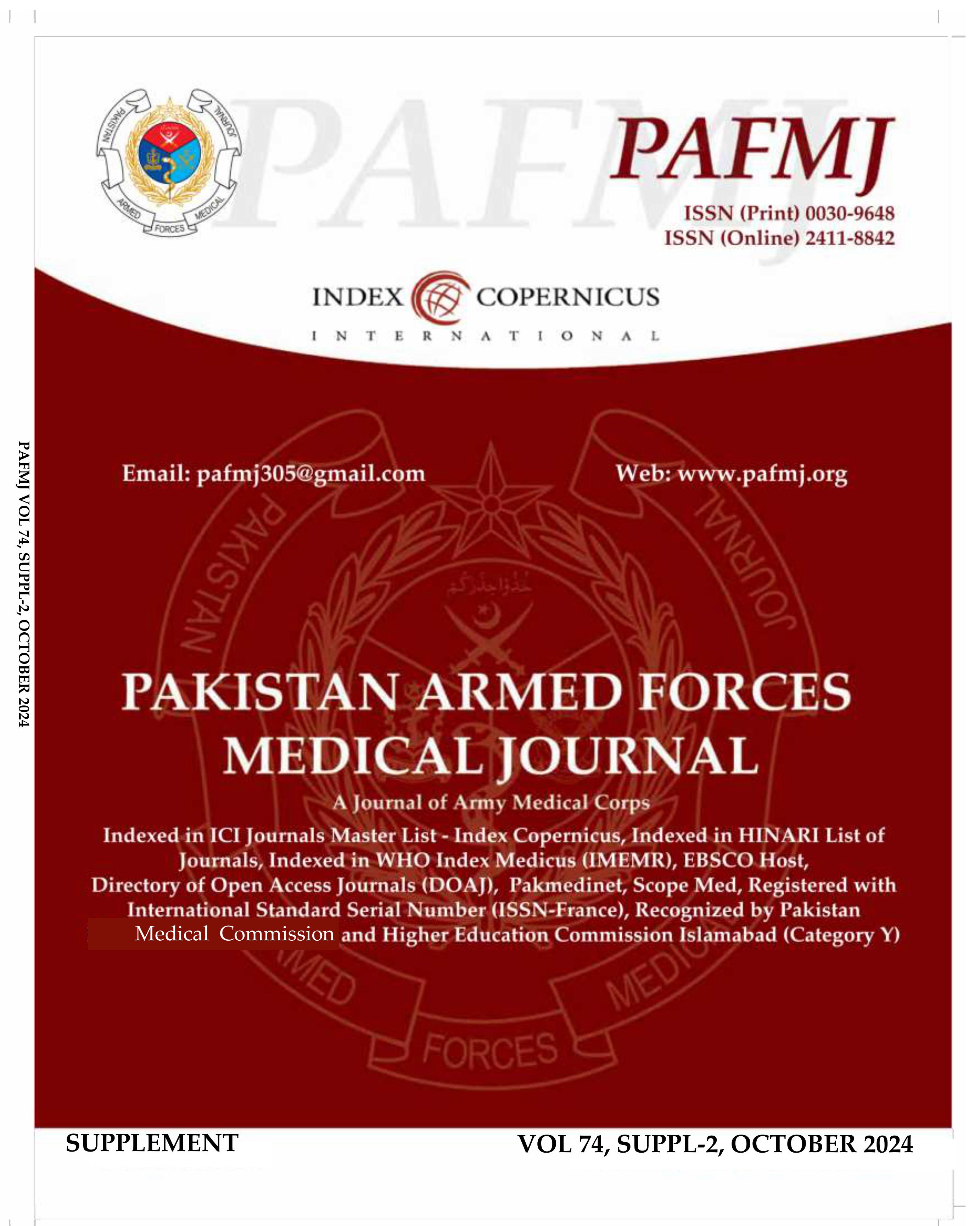Long-Term Outcome of Children With Steroid-Resistant Nephrotic Syndrome: A Single Center Experience From Pakistan
DOI:
https://doi.org/10.51253/pafmj.v74iSUPPL-2.6294Keywords:
Children, nephroticsyndrome, outcome, steroids, Pakistan.Abstract
Objective: To determine the long-term outcome of children with steroid-resistant nephrotic syndrome at a single center in Pakistan.
Study Design: Retrospective, observational study.
Place and Duration of Study: Pediatric Nephrology Department, Sindh Institute of Urology and Transplantation, Karachi, Pakistan from July 2008 to June 2014.
Methodology: The study included 153 children aged 4 months-12 years with steroid-resistant nephrotic syndrome. We collected data at the time of diagnosis and the last follow-up. The data was entered and analyzed by SPSS version 20.
Results: Among 153 children, 84(55%) were males and 69(45%) females. At the time of diagnosis, 118(77%) were hypertensive and 65 (42.5%) had microscopic hematuria. Histopathological spectrum included focal segmental glomerulosclerosis, 63(41%); minimal change disease, 33(22%); IgM nephropathy, 9 (6%); mesangioproliferative glomerulonephritis, 26(17%), membranous glomerulonephritis, 13(8%) and membranoproliferative glomerulonephritis, 9(6%). Complete remission with cyclosporine was seen in 53(34.6%), partial remission in 36(23.5%), while 53(35%) developed chronic kidney disease, of which 26(78.8%) needed renal replacement therapy. Mortality was 21(13.7 %) and 11(7.2%) were lost to follow-up. Calcineurin inhibitors’ toxicity was seen in 52(34%). One patient received renal transplant but lost the graft 6 years post-transplant due to disease recurrence.
Conclusion: Steroid-resistant nephrotic syndrome has significant long-term morbidity and mortality. Recurrence of disease in transplanted kidney is common and can result in graft loss.
Downloads
References
Noone DG, Iijima K, Parekh R. Idiopathic nephrotic syndrome in children. Lancet. 2018; 392(10141): 61-74.
Tullus K, Webb H, Bagga A. Management of steroid-resistant nephrotic syndrome in children and adolescents. Lancet Child Adolesc Health 2018; 2(12): 880-90.
Trautmann A, Bodria M, Ozaltin F, Gheisari A, Melk A, Azocar M, et al. Spectrum of steroid-resistant and congenital nephrotic syndrome in children: the PodoNet registry cohort. Clin J Am Soc Nephrol 2015; 10(4): 592-600.
Lombel RM, Hodson EM, Gipson DS; Kidney Disease: Improving Global Outcomes. Treatment of steroid-resistant nephrotic syndrome in children: new guidelines from KDIGO. Pediatr Nephrol 2013; 28(3): 409-14.
Büscher AK, Beck BB, Melk A, Hoefele J, Kranz B, Bamborschke D, et al. Rapid response to cyclosporin and favorable renal outcome in nongenetic versus genetic steroid–resistant nephrotic syndrome. Clin J Am Soc Nephrol 2016; 11(2): 245-53.
Tsai WC, Wu HY, Peng YS, Ko MJ, Wu MS, Hung KY, et al. Risk factors for development and progression of chronic kidney disease: A systematic review and exploratory meta-analysis. Medicine (Baltimore) 2016; 95(11): e3013.
Plumb L, Boother EJ, Caskey FJ, Sinha MD, Ben-Shlomo Y. The incidence of and risk factors for late presentation of childhood chronic kidney disease: A systematic review and meta-analysis. PLoS One 2020; 15(12): e0244709.
Zagury A, Oliveira AL, Montalvão JA, Novaes RH, Sá VM, Moraes CA, et al. Steroid-resistant idiopathic nephrotic syndrome in children: long-term follow-up and risk factors for end-stage renal disease. Braz J Nephrol 2013; 35(3): 191-9.
Bacchetta J, Cochat P. Primary disease recurrence—effects on paediatric renal transplantation outcomes. Nat Rev Nephrol 2015; 11(6): 371-84.
National High Blood Pressure Education Program Working Group on High Blood Pressure in Children and Adolescents. The fourth report on the diagnosis, evaluation, and treatment of high blood pressure in children and adolescents. Pediatrics 2004; 114(2 Suppl 4th Report): 555-76.
Mubarak M, Lanewala A, Kazi JI, Akhter F, Sher A, Fayyaz A, et al. Histopathological spectrum of childhood nephrotic syndrome in Pakistan. Clin Exp Nephrol 2009; 13(6): 589-93.
Gulati S, Sengupta D, Sharma RK, Sharma A, Gupta RK, Singh U, et al. Steroid resistant nephrotic syndrome: role of histopathology. Indian Pediatr 2006; 43(1): 55-60.
Mekahli D, Liutkus A, Ranchin B, Yu A, Bessenay L, Girardin E, et al. Long-term outcome of idiopathic steroid-resistant nephrotic syndrome: a multicenter study. Pediatr Nephrol 2009; 24(8): 1525-32.
Shatat IF, Schoeneman M, Flynn JT, Woroniecki RP. Association of steroid and cyclosporin resistance in focal segmental glomerulosclerosis. Pediatr Nephrol 2007; 22(6): 834-9.
Shatat IF, Becton LJ, Woroniecki RP. Hypertension in childhood nephrotic syndrome. Front Pediatr 2019; 7: 287.
Bensimhon AR, Williams AE, Gbadegesin RA. Treatment of steroid-resistant nephrotic syndrome in the genomic era. Pediatr Nephrol 2019; 34(11): 2279-93.
Trautmann A, Vivarelli M, Samuel S, Gipson D, Sinha A, Schaefer F, et al; International Pediatric Nephrology Association. IPNA clinical practice recommendations for the diagnosis and management of children with steroid-resistant nephrotic syndrome. Pediatr Nephrol 2020; 35(8) :1529-61.
Otukesh H, Otukesh S, Mojtahedzadeh M, Hoseini R, Fereshtehnejad SM, Riahi Fard A, et al. Management and outcome of steroid-resistant nephrotic syndrome in children. Iran J Kidney Dis 2009; 3(4): 210-7.
Hamasaki Y, Yoshikawa N, Nakazato H, Sasaki S, Iijima K, Nakanishi K, et al. Prospective 5-year follow-up of cyclosporine treatment in children with steroid-resistant nephrosis. Pediatr Nephrol 2013; 28(5): 765-71.
Trautmann A, Schnaidt S, Lipska-Ziętkiewicz BS, Bodria M, Ozaltin F, Emma F, et al; PodoNet Consortium. Long-Term Outcome of Steroid-Resistant Nephrotic Syndrome in Children. J Am Soc Nephrol 2017; 28(10): 3055-65.
Gulati S, Prasad N, Sharma RK, Kumar A, Gupta A, Baburaj VP. Tacrolimus: a new therapy for steroid-resistant nephrotic syndrome in children. Nephrol Dial Transplant 2008; 23(3): 910-3.
Niaudet P. Treatment of childhood steroid-resistant idiopathic nephrosis with a combination of cyclosporine and prednisone. J Pediatr 1994; 125(6): 981-6.
Sinha A, Sharma A, Mehta A, Gupta R, Gulati A, Hari P, et al. Calcineurin inhibitor induced nephrotoxicity in steroid resistant nephrotic syndrome. Ind J Nephrol 2013; 23(1): 41-6.
Cheong HI, Han HW, Park HW, Ha IS, Han KS, Lee HS, et al. Early recurrent nephrotic syndrome after renal transplantation in children with focal segmental glomerulosclerosis. Nephrol Dial Transplant 2000; 15(1): 78-81.
First MR. Living-related donor transplants should be performed with caution in patients with focal segmental glomerulosclerosis. Pediatr Nephrol 1995; 9(1): S40-2.
Downloads
Published
Issue
Section
License
Copyright (c) 2024 Lubna Aman, Madiha Aziz, Noureen Akhter, Muhammed Mubarak, Ali Asghar Lanewala, Seema Hashmi

This work is licensed under a Creative Commons Attribution-NonCommercial 4.0 International License.















